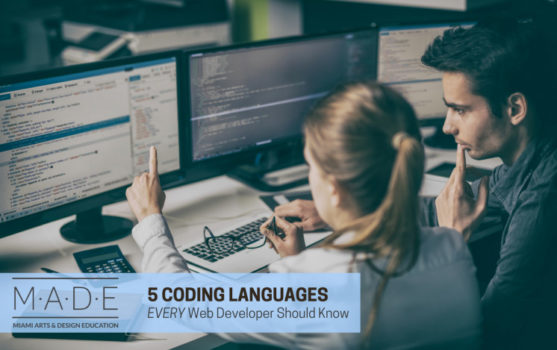What’s Your End Game?
To help you make your career choice, let’s understand how some of the most popular coding languages are categorized, and what role they play in web development. Armed with that information, you can then decide which web development avenue you wish to pursue as a career choice:
- Front End Languages: Typically, these are languages used by coders to develop features and functionality that interacts directly with the user. If you are planning to make a career out of developing websites, web applications or mobile apps, then you should consider learning a front-end language.
- Browser-based front-end coding choices include: JavaScript, CSS and HTML, amongst scores of others
- Desktop front ends are popularly developed using Visual Basic 6, Java and .NET
- iOS Mobile app developers prefer Objective C, while Java is a popular choice for Android app developers
- Back End Languages: Most often (but NOT always), back end code is developed to create functionality that processes web server commands, or to interact with server plug-ins. This code usually acts as a go-between for the inputs provided by a user through a front-end interface, and the server (or a database residing on the server) that’s at the back-end. In a browser-based environment, the back-end code serves as a communicator or facilitator between the browser and the database.
- Popular back-end coding languages include Java or PHP (amongst others)
Language and Career Choices
Whether you choose to learn a Front-End language, or master Back-End language coding skills, depends upon what type of a developer you wish to become.
For instance, if you wish to become a front-end coder, popular job openings will include:
- Web Designer
- Front End Developer
- User Interface or User Experience designer (or UI/UX designer)
- Interaction Designer/Developer
Mastering front-end coding languages like HTML, CSS and JavaScript, will open the doors to many front-end development tips and techniques, such as responsive development, color theory, grid system, layouts.
- HTML helps create and organize web content in an orderly arrangement through the browser
- CSS is usually an HTML accompaniment (or ally), which helps to define how content is styled on the website, including fonts, layouts and colors
- JavaScript (totally different from, and not to be confused with Java!) introduces a broad array of interactivity to the website, such as forms, buttons, drop-down lists and menus.
Keep in mind, most front-end creations are “static”, since they do not get involved in heavy data creation or number crunching.
If, on the other hand, your interest lies less in creating front-end user interfaces, and more in handling back-end processes, then you need to master a few back-end coding languages, such as Java or PHP.
- Java is a programming language that is almost ubiquitous these days, and powers hundreds of thousands of websites and applications. Java code is especially suitable for mobile computing, and is found on almost all Android-based devices. One endearing feature of Java is that it’s code is “WORA” – Written Once, Run Anywhere. And, that makes Java coders a very special commodity!
- PHP’s strength lies in the fact that your code can do many different things, such as collect data from web forms (e.g. Contact Us form), send and receive cookies, or generate dynamic web pages. While technically you could also use PHP to write desk-top applications with a nice front-end, there are other front-end coding languages better suited for that application
Most back end developers are more experienced than front end coders. In fact, many of them have several years of front end coding under their belt, before they move onto back end coding. In some environments, such developers (that are proficient with front and back end technologies) are called Full Stack Developers.
Back end languages help create dynamic sites, such as Twitter and Facebook, where users interact with the front end, which then causes the environment to change dynamically through the back end (server, database).
Other Valuable Coding Skills
Here is what you need to keep in mind: As a web developer – regardless of it being for front or back end coding, it’s always nice to have as many coding skills as possible. While you are in the process of honing your coding skills, you may get an opportunity to master other elements of a particular language – you should grab it immediately!
For instance, while being exposed to JavaScript, you’ll likely be exposed to associated libraries, like jQuery, or learning CSS will introduce you to extensions LESS and Sass. With these additional skills, you’ll be able to better manage your code, and organize your coding projects more efficiently.
It also pays to learn other coding skills, such as SQL – which could help you manipulate data from a database that you may have sent there using a front-end interface you created. You can even use your SQL skills to test and validate whether your front end is working as intended.
Also, when you are a back-end developer, you’ll often have to perform repetitive tasks when managing, administering or maintaining the backend of the website. These tasks are usually performed through back-end management tools, that let you access specific options embedded under specific sub-menus, entrenched under a series of menus. Accessing those options takes too many keystrokes and mouse clicks!
Some back-end developers therefore learn to program in Shell languages, which can let you execute a series of 8 to 10 steps – repeatedly – with just a single command!
All fired up to launch a career as a Web Designer and Developer? Get a head start on your career by checking out the web design classes available in Miami.

